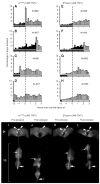Light and peptidergic eclosion hormone neurons stimulate a rapid eclosion response that masks circadian emergence in Drosophila
- PMID: 18587121
- PMCID: PMC2760273
- DOI: 10.1242/jeb.015818
Light and peptidergic eclosion hormone neurons stimulate a rapid eclosion response that masks circadian emergence in Drosophila
Abstract
Light signals can entrain circadian clocks, but they can also mask aspects of the circadian output. We have analyzed the masking effects of a lights-on (LOn) signal on Drosophila eclosion. The LOn response results in 12-21% of the flies that emerge on a given day eclosing within 10 min of the LOn signal. Flies that lack the neuropeptide eclosion hormone (EH), or in which its release is inhibited by the tetanus toxin light chain, lack the response. Optic photoreceptors in both the ocelli and the compound eyes appear to be required for the response. The LOn signal has two effects: (1) it drastically reduces the interval between EH release and eclosion, presumably by suppressing a transient descending inhibition that immediately follows EH release, and (2) it stimulates premature EH release. The LOn signal does not influence the latency of wing spreading, an EH-regulated post-ecdysis behavior.
Figures









References
-
- Aschoff J. Exogenous and endogenous components in circadian rhythms. Cold Spring Harbor Symp Quant Biol. 1960;25:11–28. - PubMed
-
- Ashburner M. Drosophila: A Laboratory Manual. Cold Spring Harbor, NY: Cold Spring Harbor Laboratory Press; 1989.
-
- Baker JW, McNabb SL, Truman JW. The hormonal coordination of behavior and physiology at adult ecdysis in Drosophila melanogaster. J Exp Biol. 1999;202:3037–3048. - PubMed
-
- Binkley S, Mosher K, Reilly K. Circadian rhythms in house sparrows: Lighting ad lib. Physiol Behav. 1983;31:829–893. - PubMed
Publication types
MeSH terms
Substances
Grants and funding
LinkOut - more resources
Full Text Sources
Molecular Biology Databases

